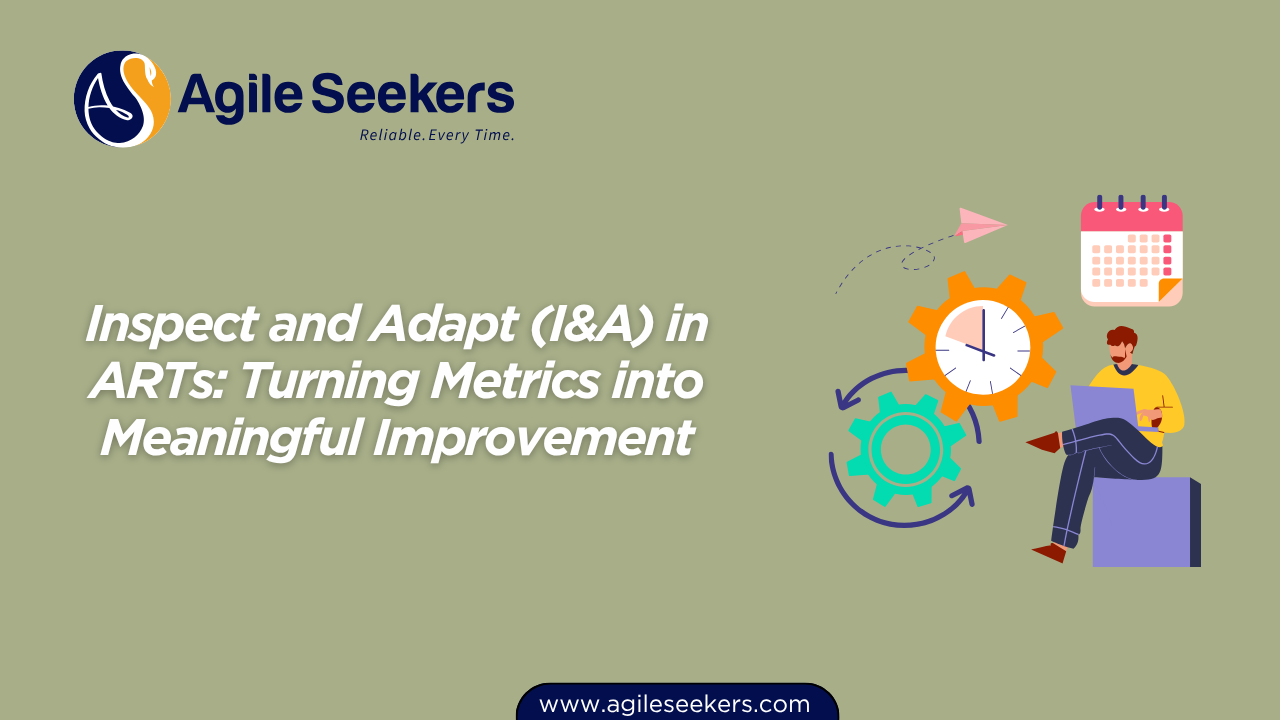Inspect and Adapt (I&A) in ARTs: Turning Metrics into Meaningful Improvement

Inspect and Adapt (I&A) is more than a ceremony—it’s a cornerstone of relentless improvement in SAFe’s Agile Release Trains (ARTs). Done right, it turns raw metrics into actionable insights that drive measurable progress across teams and programs. In this post, we’ll explore how the I&A event fuels improvement by connecting data, collaboration, and a culture of accountability.
What Is the Inspect and Adapt (I&A) Event?
The I&A event takes place at the end of every Program Increment (PI). It provides a structured opportunity for the ART to reflect on progress, inspect deliverables, review performance metrics, and identify systemic issues. The goal is not only to surface problems but to resolve them by identifying improvement items and turning them into backlog items.
The I&A event includes three main components:
-
PI System Demo
-
Quantitative and Qualitative Measurement Review
-
Problem-Solving Workshop
Each of these activities plays a unique role in helping ARTs evolve continuously toward higher value delivery.
Why Metrics Matter—but Only If You Act on Them
Metrics by themselves don’t improve performance. They’re signals—clues pointing to underlying causes. Many ARTs collect velocity, predictability, defect trends, feature cycle time, and flow efficiency. But unless these are reviewed in context and acted upon, they become dashboard noise.
SAFe emphasizes Lean-Agile principles by encouraging data-driven decision-making. The I&A event puts this into action by:
-
Correlating metrics with real outcomes
-
Making patterns visible across teams
-
Elevating persistent bottlenecks to system-level visibility
To do this effectively, Release Train Engineers (RTEs) must guide teams in understanding which metrics truly indicate value flow and delivery health. This makes the SAFe Release Train Engineer Certification Training a strategic investment for leaders managing ART performance.
Conducting an Effective System Demo
The PI System Demo gives stakeholders a holistic view of what the ART has delivered. It brings transparency, creates alignment, and sets the tone for the retrospective discussion. It’s important that this demo isn’t cherry-picked—it should represent work from all teams across the train.
Pro tip: Use the demo as a conversation starter. If quality is inconsistent, velocity is erratic, or planned objectives aren’t met, dig into the causes. This opens the door to candid dialogue in the later parts of the I&A.
Facilitating a system demo requires collaboration across Scrum Masters, Product Management, and System Architects. Leaders trained through Leading SAFe Agilist Certification Training bring the right mindset to ensure demos stay outcome-focused, not status-driven.
Making Sense of Metrics in the Measurement Review
This segment of I&A focuses on quantitative and qualitative assessment. Metrics often reviewed include:
-
Team Predictability Measure (Actual/Planned Business Value)
-
Feature Cycle Time
-
Cumulative Flow Diagram (CFD)
-
Defect Injection/Removal Rates
-
Innovation Metrics like spike usage or enabler flow
The key is not just to collect these metrics but to review them in context. Are stories getting blocked due to unclear requirements? Are features stacking up in integration? Is business value delivery consistent with PI goals?
For Product Owners and Product Managers, this is where SAFe Product Owner/Product Manager (POPM) Certification helps them lead backlog refinement using evidence—not guesswork.
The Problem-Solving Workshop: Where Real Change Happens
This is the heart of the I&A event. It follows a structured Lean problem-solving approach:
-
Identify the problem
-
Root cause analysis (often using 5 Whys or Fishbone diagrams)
-
Brainstorm improvement actions
-
Create improvement backlog items
-
Assign owners and due dates
The goal is not to create a list of complaints but to identify root-cause issues and take ownership of fixing them. This turns complaints into commitments.
Scrum Masters, often the facilitators here, play a crucial role in driving these sessions. Trained Scrum Masters—especially those who’ve completed SAFe Scrum Master Certification—understand how to balance psychological safety with accountability. For complex trains, having an SAFe Advanced Scrum Master enhances the effectiveness of cross-team improvements.
Moving from Output to Outcome
The real power of Inspect and Adapt lies in how insights are followed through. Improvement items identified during I&A should:
-
Be added to the Program Backlog
-
Be tracked and owned just like any other deliverable
-
Have clear acceptance criteria and progress checkpoints
Treating these items with the same rigor as feature delivery sends a strong message: improvement is not optional—it’s part of delivery.
Common Pitfalls to Avoid
-
Treating metrics as a report card: The I&A isn’t an audit; it’s a learning opportunity.
-
Overloading the improvement backlog: Pick 2–3 high-impact actions rather than a laundry list.
-
Skipping root cause analysis: Without it, you fix symptoms, not systems.
-
Lack of leadership support: Without backing from Product Management and leadership, improvement work gets deprioritized.
Encouragingly, these issues are solvable. With the right structure, facilitation, and training, ARTs evolve toward high performance.
I&A: A Cultural Shift Toward Learning Organizations
I&A isn’t just a tool—it’s a mindset. It signals to the organization that:
-
Failure is not punished but explored
-
Metrics are not weapons but guides
-
Change is not a one-time event but a continuous flow
This aligns perfectly with the principles of Lean-Agile leadership, making Leading SAFe training critical for leaders at all levels.
Final Thoughts
Turning metrics into meaningful improvement is one of the most powerful things an ART can do. The Inspect and Adapt event provides the structure, but success depends on mindset, leadership, and follow-through.
To embed this into your ART culture:
-
Train your leaders with Leading SAFe
-
Equip Scrum Masters through SAFe Scrum Master Certification
-
Empower teams with SAFe POPM Certification
-
Support RTEs with SAFe Release Train Engineer Certification
And above all—treat improvement as a product of its own, with the same care and attention you give to any feature.
Also read - Understanding ART Sync
Also see - Value Stream Mapping for ARTs




















